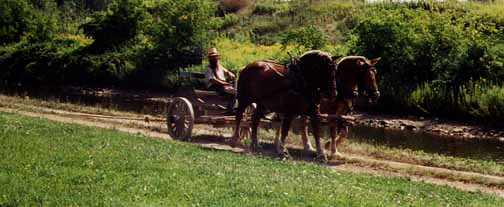American Sabbatical 004: 9/2/96
Erie Canal.
9/2.. Erie Canal.
Back on the road again after hiding out in the Adirondacks. Winding out of the rusty
old mountains into the New York lake country. The Adirondack wilderness
preserve was created back in TR’s day and the long-groomed feeling,
the lack of buildings on the hilltops, the postcard sensibility
is vaguely disquieting. Is this the way we would have Northern
Maine? It’s all very sterilized somehow, and I’m surprised that
bothers me. The feeling is a sort of generalized Camdenization,
until you pass out of the park, into the vacationland hoopla of
Labor Day in the unprotected hills. That zone is very blue-collar,
with waterslides and jet skis. Lettin her rip for the end of summer.
We dodge off the Utica road and stumble into Rome, Festiva pilgrims
on the road to Historia. There is no there there in Rome (New
York) until you break out of the roadgrid into the city center,
which circles Fort Stanwick, a reconstructed colonial fort with
palisades, block houses and all the ambiance of mall city. Then
again, this must have been where the Indians came to shop. This
was a major way station between The Hudson-Mowhawk system and
the big lakes, which is why the colonial fort straddles this passway.
(Now it’s an Air Force town).
| We kept zigging and zagging, so the musket balls wouldn’t get
us, and tumbled on the Erie Canal Village, just outside Rome,
another reconstruction, along a bit of the original canal. A canal
boat ride pulled by mules, guides in suspenders and straw hats,
all the miscellaneous paraphernalia that gravitates to a museum.
Peggy loves the little details which personalize the historical
record, and she sniffs around these places with delight. I have
little tolerance for pay-for-view antiquity, so I stay outside
and do watercolored drawings. Pretty sorry stuff, if I do say
so myself. |
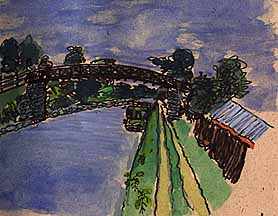
Old Canal
|
Following the old canal I’m reminded how much American history
is about the road. So many of the big sites in our cultural memory
are places of passage. Fort Popham. Ticonderoga. The Erie Canal.
The Cumberland Gap. Southpass. We are making a pilgrimage to follow
pilgrims. Were they all trying to find America?
(Memo #4)
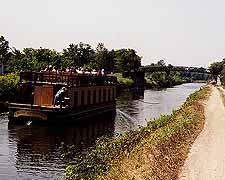
Barge on the Old Canal
|
Sept. 2 - Erie Canal
WHO? promoter DeWitt Clinton and Irish immigrant laborers
WHAT? Erie Canal (363 miles long) opened up Midwest
WHERE ? connected Lake Erie with Hudson River, through Mohawk
Valley
WHEN? opened 1825
HOW? four foot deep ditch + locks constructed
Topics: Erie canal, transportation, public works.
|
|
Questions:
-Why would you want canal boats to go SLOW?
-What supplies would be sold in a store catering to the canal
trade?
-Why would the tow rope be 75-150 feet? |
|
Down out of the Adirondacks today, by blue lakes and endless lines
of small vacation cabins. As we descend and get closer to the
park border, there are more cabins and tourists. From Syracuse
or Utica the park is only an hour or so away. How nice.
At Rome we went to Erie Canal Village near the spot where the
canal was first started. Rome is at a place the Indians called
the BIG CARRY where canoes were hauled between two rivers, one
of which leads east to the Mohawk, one west to the lakes. The
site was contested in the French and Indian war and the Revolution.
In the 1810’s it seemed a logical place to start a canal to link
the Hudson with the Great Lakes. This reconstructed village itself
is fictional - buildings were hauled from other areas. The layout
is village around a square, complete with bandstand, next to a
section of canal.
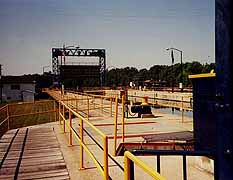
Canal Today
|
The canal was fascinating. This section of a half mile or so is
well-maintained, with a proper towpath for the horses along one
side They have a canal boat - complete with seating on the roof
- that is hauled authentically by two horses. It is about a 45
minute ride. There are many other canal sites in New York state
- you can see the canal from many roads. It’s still used. |
| The canal itself was only 4 feet deep, 40 feet wide at the top
and 28 feet wide at the bottom ( to allow for sloping banks).
The museum claimed that the men who constructed it (with no experience)
were really part of the first American school of engineering.
Wonderful pictures of the canals and boats, canal families, cargoes,
celebrations. People swam (!) in them in the summer, skated on
them in the winter. Children would ride the tow ropes, and the
man leading the horses would carry an iron bar with which to whack
the rope, and jolt the boys off (!). There were dry docks for
repairs, boatyards to construct boats, etcetera The museum has
a reconstruction of a section of a shared stateroom with fold-down
bunks along the sides. |
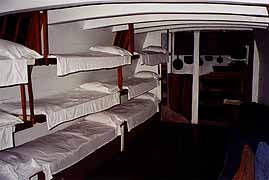
Barge Interior
|
|
Answers:
1. A fast boat throws waves that erode the canal walls. This is
a danger today in Maine's rivers. Speed pollution.
2. A store would sell bottled water in pottery jugs, because the
canal water was foul. Also tow ropes and lanterns.
3. The tow ropes are 75-150 feet long, so the boat's drag will
be directly behind the team of horses (and they can pull efficiently). |
|
